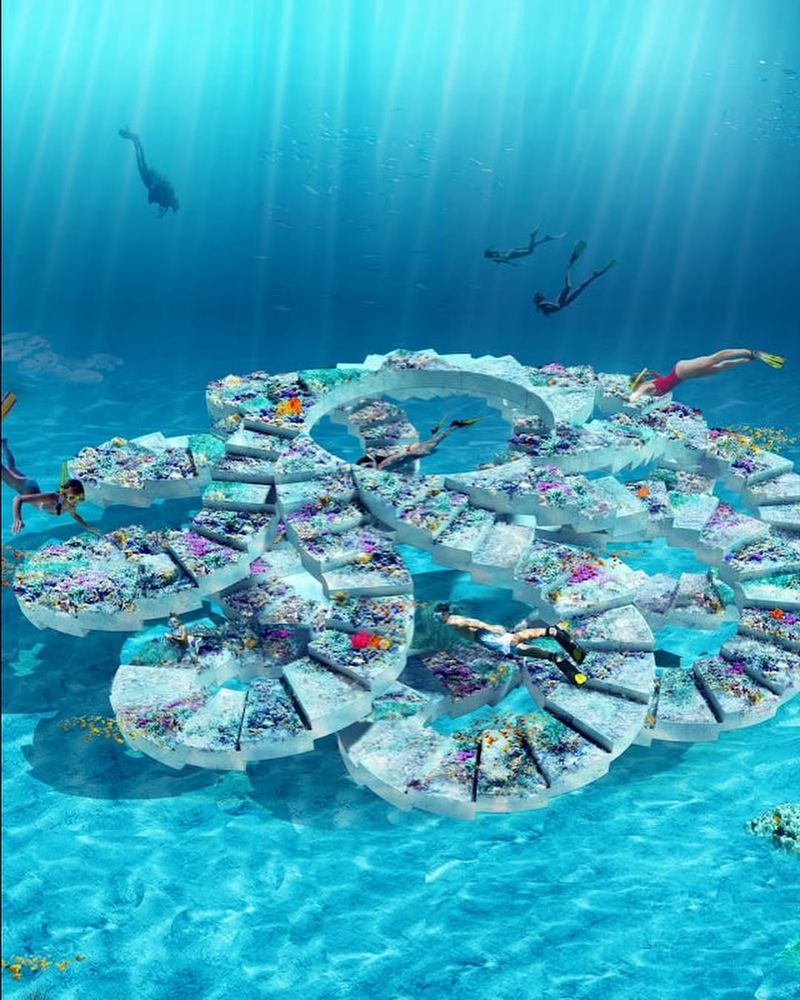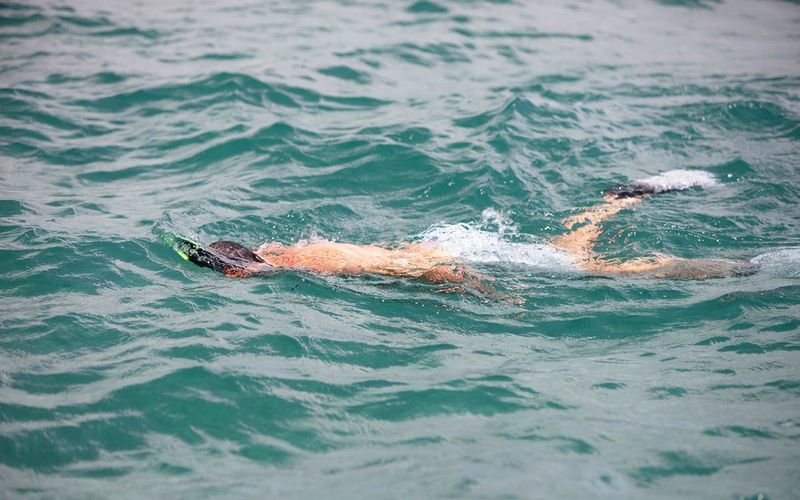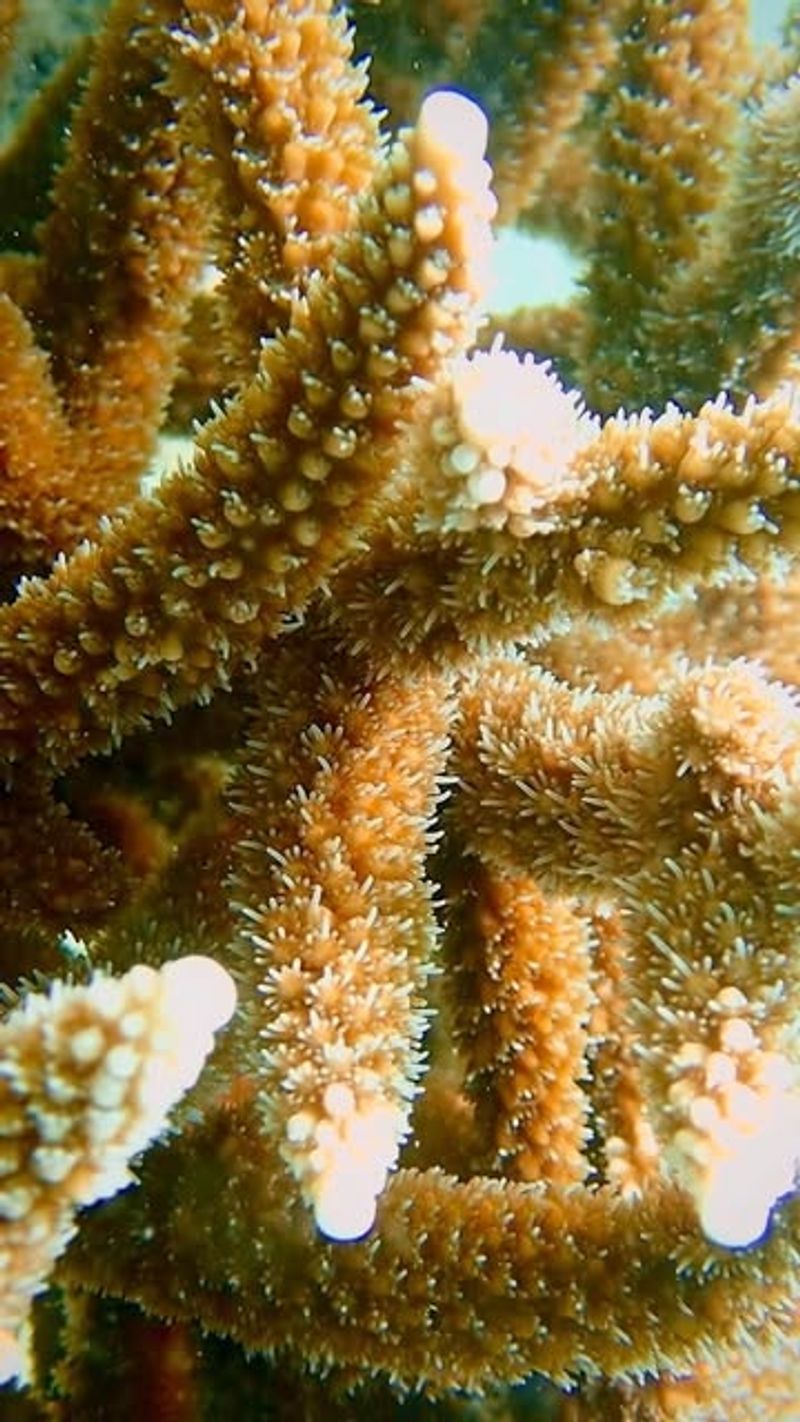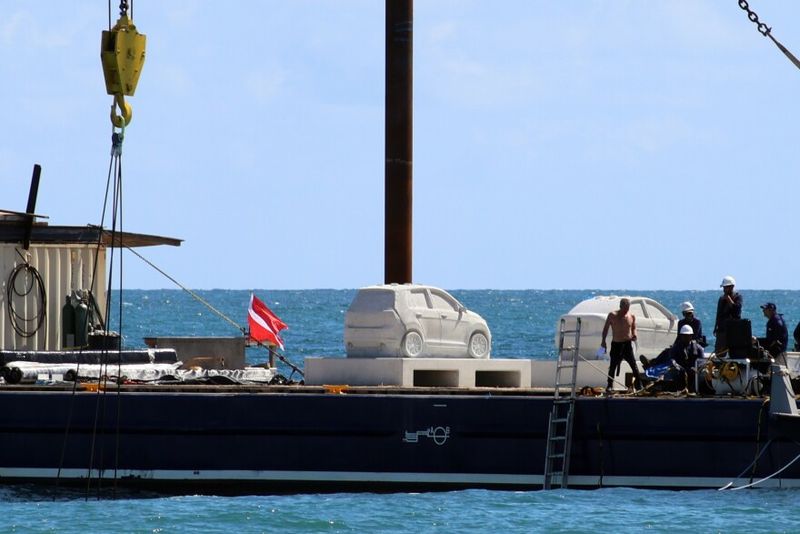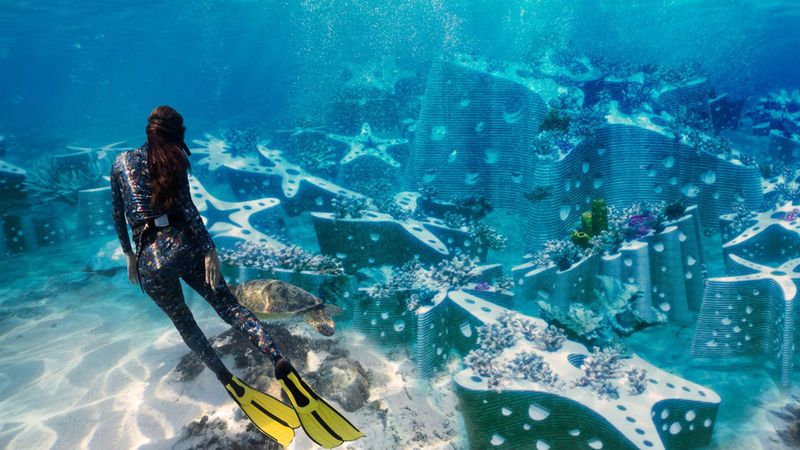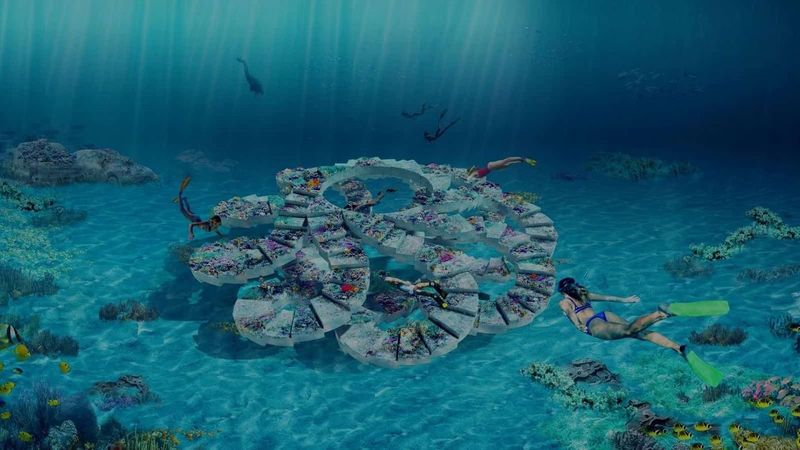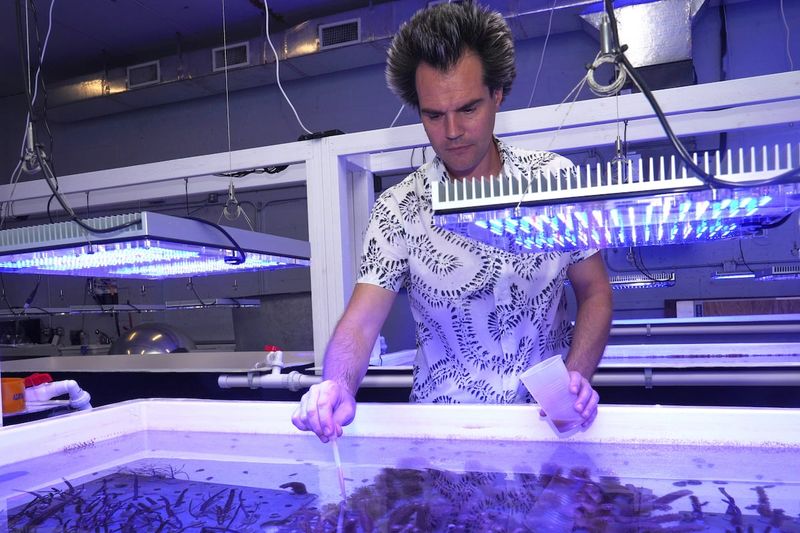Just off Miami Beach, a surreal traffic jam waits beneath the waves. Twenty-two concrete cars rest on the sandy ocean floor, creating an underwater gallery where art and marine science meet. This free sculpture park invites snorkelers and divers to explore a living reef that grows more colorful every month.
1. What it is: art meets reef restoration
Twenty-two life-size vehicles cast from marine-grade concrete form a ghostly convoy on the seafloor. Each sculpture was engineered with rough, porous surfaces that invite coral polyps to attach and grow.
Called Concrete Coral, this installation doubles as a habitat for reef fish seeking shelter and feeding grounds. Artists and marine biologists worked side by side to design shapes that look dramatic from above yet function like natural limestone outcrops below.
Over the coming years, algae, sponges, and soft corals will blanket the cars, transforming steel-age symbols into thriving marine ecosystems. The project proves that public art can heal oceans, not just decorate them.
2. Exactly where it sits
The car cluster lies roughly 780 feet from shore, between 4th and 5th Streets on Miami Beach. At around 20 feet deep, the site sits in a sandy patch bordered by natural reef ridges.
From the beach, you can scan the horizon and estimate the zone, though the sculptures remain hidden below the surface. Swimmers and paddlers often pass directly overhead without realizing an art gallery rests beneath their fins.
Always enter the water from a lifeguard-patrolled section and swim straight out. Boat traffic can appear quickly, so stay alert and use a brightly colored dive flag if you venture offshore alone.
3. It’s free: no ticket required
REEFLINE operates as a true public park, open to anyone who can safely swim offshore. There are no admission gates, no timed entries, and no wristbands to scan.
If you already own a mask, snorkel, and fins, your visit costs nothing beyond travel to Miami Beach. Guided tours and equipment rentals do charge fees, but independent exploration remains completely free.
This model mirrors land-based sculpture gardens in cities worldwide, proving that cutting-edge art does not need a paywall. The ocean itself becomes the gallery, and every visitor holds a lifetime membership from the moment they wade in.
4. How to see it: snorkel or dive
Strong snorkelers can hover at the surface on calm days, peering down through clear water to spot the car outlines. Scuba divers enjoy the full experience, swimming alongside doors, hoods, and wheel wells encrusted with tiny coral recruits.
Depth sits around 20 feet, shallow enough for recreational divers yet deep enough that snorkelers need good breath-hold skills to descend for close-up photos. Always dive with a buddy, and check local marine forecasts before heading out.
If you are new to open-water swimming, consider booking a guided snorkel tour. Experienced guides know currents, entry points, and the exact GPS coordinates to save you time searching.
5. Why vehicles?
Argentine artist Leandro Erlich chose cars to flip the script on climate change. Automobiles symbolize fossil fuels and rising emissions, yet here they become scaffolding for ocean recovery.
The rough concrete castings mimic natural reef texture, offering countless nooks where baby fish hide from predators and coral larvae settle. Within months, green algae films the surfaces; within years, branching corals may sprout from bumpers and mirrors.
Erlich calls the piece an underwater traffic jam frozen in time. Instead of honking horns and exhaust fumes, you hear only the click of parrotfish grazing and the gentle surge of waves overhead.
6. A phased park that will grow
Concrete Coral marks phase one of an ambitious vision: a multi-mile underwater sculpture trail stretching along Miami Beach. Future phases will feature works by additional artists, each addressing themes from sea-level rise to plastic pollution.
Planners envision snorkelers island-hopping between installations, much like gallery-goers stroll from room to room in a museum. Each site will host different species and artistic styles, creating a living mosaic beneath the waves.
Construction timelines depend on funding, permitting, and environmental reviews. If all goes smoothly, new sculptures could debut every year, turning South Florida into a global hub for underwater public art and marine restoration.
7. Coral that survived a bleaching event
Scientists selected 2,200 gorgonian coral fragments for the project, all grown in local Miami nurseries. These soft corals endured the brutal 2023 bleaching event, when ocean temperatures spiked and reefs across Florida turned ghostly white.
Survivors carry genes for heat tolerance, making them ideal candidates for restoration. Researchers carefully attach small colonies to the concrete using marine epoxy, spacing them to allow growth without crowding.
Over time, these transplants will reproduce, spreading larvae to neighboring reefs. The cars become both art gallery and coral farm, proving that human creativity can support natural resilience when science and design work hand in hand.
8. Backed by the City of Miami Beach
Miami Beach committed serious resources to REEFLINE, including a five-million-dollar bond to fund construction, permitting, and long-term monitoring. City leaders view the project as a win for both tourism and environmental health.
Public funding signals that underwater art is not a fringe experiment but a legitimate infrastructure investment. Coastal cities worldwide watch Miami closely, curious whether art reefs can boost marine biodiversity while drawing eco-tourists.
Partnerships span municipal departments, from parks and recreation to climate resilience teams. By weaving culture into coastal planning, the city hopes to inspire residents and visitors alike to care more deeply about ocean ecosystems.
9. The masterminds behind it
Ximena Caminos, a cultural producer with a passion for oceans, dreamed up REEFLINE as a way to make marine conservation tangible. She partnered with Shohei Shigematsu of the renowned architecture firm OMA to master-plan the corridor.
Together, they assembled a dream team: sculptors, marine biologists, engineers, and community advocates. Each voice shaped the final design, ensuring the park would be safe, accessible, and ecologically sound.
Caminos describes the collaboration as controlled chaos, where artistic vision met hard science and bureaucratic reality. The result is a blueprint other coastal cities now study, hoping to replicate the magic of art that breathes life back into damaged reefs.
10. Best conditions to go
Morning hours typically offer the clearest water and lightest winds. Afternoon sea breezes can chop up the surface, reducing visibility and making the swim more strenuous.
Always check rip-current advisories posted at lifeguard stands before entering the ocean. Even on sunny days, strong currents can sweep swimmers parallel to shore, turning a leisurely snorkel into an exhausting ordeal.
Weather apps with marine forecasts help you plan ahead. Look for days with wave heights under two feet and offshore winds below ten knots. When conditions align, the underwater view rivals any aquarium, and the cars emerge from the blue like ghosts from a dream.
11. Gear and safety basics
Pack a well-fitting mask, snorkel, and fins. A brightly colored surface marker or dive flag alerts boaters to your presence, a critical safety step when swimming far from shore.
Never touch the sculptures or any coral growing on them. Oils from your skin can harm fragile polyps, and sharp barnacles or fire coral can cut your hands. Stay neutrally buoyant and keep your fins up to avoid stirring sediment.
Obey lifeguard instructions and posted signs. If you feel tired or notice a current pulling you sideways, swim diagonally toward shore rather than fighting straight in. Staying within your skill level keeps the adventure fun instead of frightening.
12. What you’ll likely see
Schools of sergeant majors, blue tangs, and parrotfish dart in and out of window frames and wheel wells. Juvenile grunts use the crevices as nurseries, hiding from larger predators that patrol the open sand.
Coral fragments attached during installation will expand slowly, sending out new branches and polyps. Algae films coat the concrete, providing grazing grounds for herbivorous fish that keep the surfaces clean.
Each visit reveals something new: a curious octopus investigating a side mirror, a spiny lobster tucked under a bumper, or a bright nudibranch crawling across a hood. The sculpture evolves month by month, blurring the line between human-made art and natural reef.
13. Where to look from shore
During installation, a massive 159-foot barge anchored near 4th and 5th Streets to lower the cars into position. That same stretch serves as your visual reference today.
Stand at the water’s edge and scan about 780 feet out. You will not see the sculptures themselves, but you may notice dive flags or snorkelers clustered in that zone on busy weekends.
Use caution when swimming offshore. Boat traffic exists beyond the swim buoys, and currents can shift quickly. Always buddy up, and consider wearing a brightly colored swim cap so lifeguards can track your progress from the tower.
14. Photography tips underwater
Water absorbs red wavelengths first, so attach a red filter to your camera or adjust white balance to the blue-water preset. This trick restores warmer tones and prevents every shot from looking washed out.
Keep your fin kicks slow and steady to avoid stirring up sand clouds that ruin visibility. Shoot slightly upward to silhouette the car shapes against the bright surface, creating dramatic contrast.
Timing matters: midday sun penetrates deepest, illuminating details on the sculptures. Early morning offers softer light and fewer swimmers in your frame. Experiment with angles, and do not be afraid to take dozens of shots to capture that one perfect composition.
15. How to support or learn more
Follow REEFLINE on social media for behind-the-scenes updates, coral-planting schedules, and announcements about new art installations. The official website hosts educational resources, including lesson plans for teachers and virtual-reality tours for landlocked fans.
Volunteer opportunities occasionally open for coral nursery work or beach cleanups tied to the project. Even small actions, like sharing photos and tagging the organization, help spread awareness and attract funding for future phases.
Consider donating if the project resonates with you. Nonprofit supporters fuel research, monitoring, and community outreach that keep the park thriving. Every dollar helps transform concrete into living reef and inspires other cities to reimagine their coastlines.


